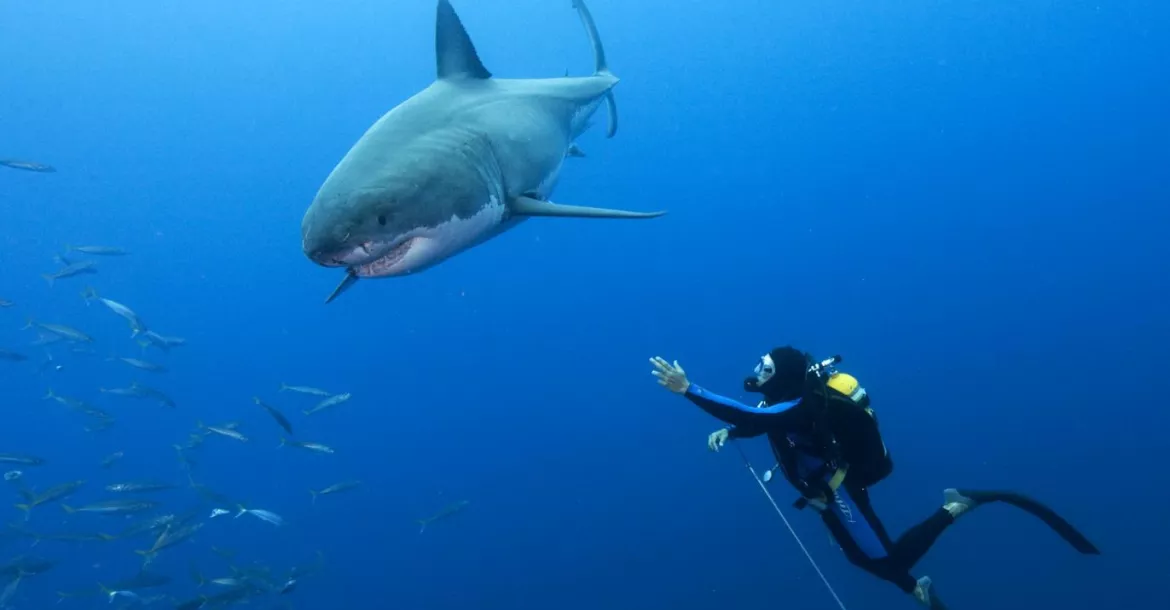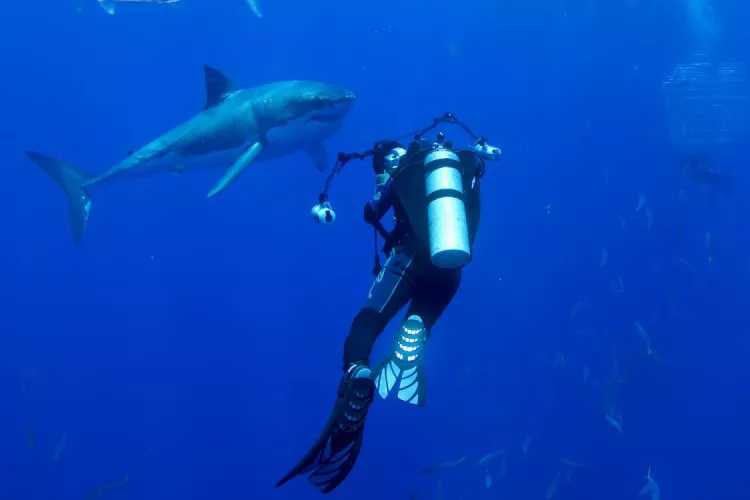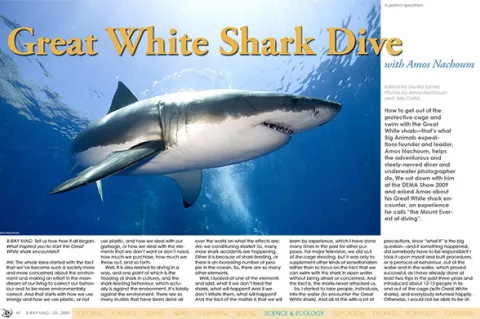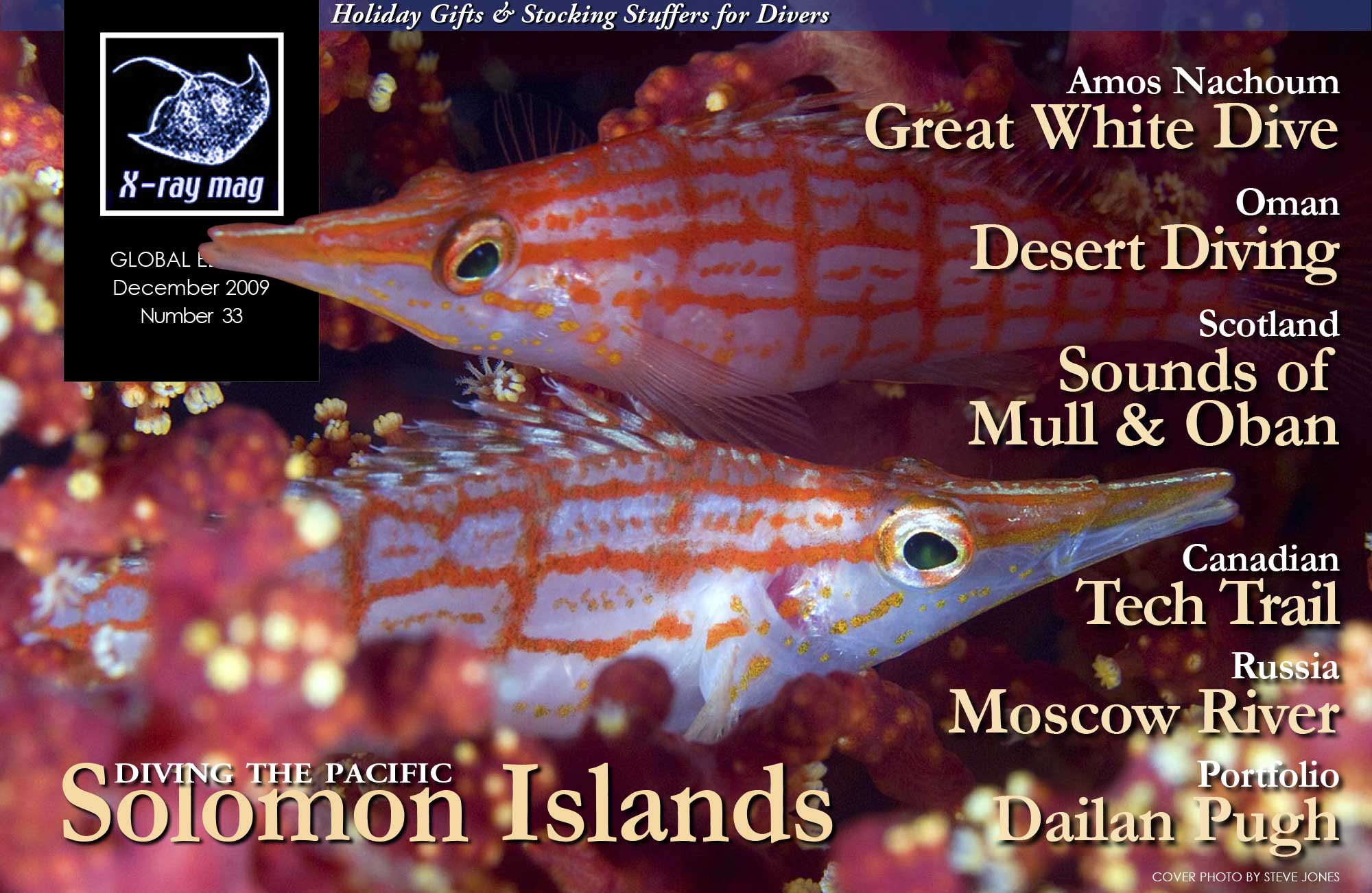How to get out of the protective cage and swim with the Great White shark—that’s what Big Animals expeditions founder and leader, Amos Nachoum, helps the adventurous and steely-nerved diver and underwater photographer do.
Contributed by
X-RAY MAG: Tell us how how it all began. What inspired you to start the Great White shark encounters?
AN: The whole idea started with the fact that we’ve become such a society more and more concerned about the environment and making an effort in the mainstream of our living to correct our behaviour and to be more environmentally correct. And that starts with how we use energy and how we use plastic, or not use plastic, and how we deal with our garbage, or how we deal with the elements that we don’t want or don’t need, how much we purchase, how much we throw out, and so forth.
Well, it is also related to diving in a way, and one point of which is the flooding of shark in cultures, and the shark-feeding behaviour, which actually is against the environment. It’s totally against the environment. There are so many studies that have been done all over the world on what the effects are: Are we conditioning sharks? So, many more shark accidents are happening. Either it is because of shark-feeding, or there is an increasing number of people in the ocean. So, there are so many other elements.
Well, I looked at one of the elements and said, what if we don’t feed the sharks, what will happen? And if we don’t irritate them, what will happen? And the fact of the matter is that we will learn by experience, which I have done many times in the past for other purposes. For major television, we did out-of-the-cage shooting, but it was only to supplement other kinds of sensationalism rather than to focus on the fact that we can swim with the shark in open water without being afraid or concerned. And the fact is, the sharks never attacked us.
So, I started to take people, individuals, into the water (to encounter the Great White shark). And all of this with a lot of precautions, since “what if” is the big question—and if something happened, did somebody have to be responsible? I took it upon myself and built procedures, or a protocol of behaviour, out of the water and in the water, which proved successful, as I have already done at least two trips in the past three years and introduced about 12-15 people in to and out of the cage (with Great White sharks), and everybody returned happily. Otherwise, I would not be able to be sitting here and talking to all of you and smiling about it, with the pictures to show.
As I started to tell people, in all businesses especially new ones, there are two elements which are the most dangerous: one, being short on time; and two, being short on money. I decided to eliminate those two issues. If I can have all the time in the world and I charge enough to take this kind of project on hand, hopefully, I will be successful.
So, I wanted to go on a three-day trip to Guadelupe. We now have a trip with five days in the water. So, we have all the time in the world. I have five days. Rather than take 20 people, I take ten people in the boat. And from these ten people, only five are allowed to go out of the cage. And those five, I take only one at a time out of the cage.
So, now people know that they only get one time out of the cage, and for this, they pay extra, whatever that extra is. And I don’t promise more than one encounter. And for this, they are willing to do it, because it is so avant garde, it’s so unique, it’s so exotic, or so whatever it is. And so, people are willing to make this effort and this investment in time and money. As it happens during the trip, people get three to five times a day, and over five days, 25 chances to be out of the cage with the sharks and totally safely.
Every time I go out of the cage, I have a safety diver with me. The safety diver is actually a shark researcher. The shark researcher/safety diver has a stick, not a bent stick, just a stick in his hand. And the customer is sandwiched between the two of us. And that’s how we conduct it. We go out for 15-20 minutes at a time, half an hour, the sharks stay around us, because the other boat has already been chumming on the surface, and we take the cage, and we go to 30-40 feet below.
The sharks are roaming in mid-water and they come at us, they look at us, they pass by us, and that’s when we are able to take those wonderful pictures and to be with them in the same water. And they are not irritated by our presence. On the contrary, they come by and take a look, come very close, and as long as we are flashing them with the cameras—we are taking pictures, because that is what we do in the water or what everybody wants to do, either because the camera and strobe is like a safety shield or you want to hide behind the camera.
All of a sudden, you don’t seem in danger, perhaps because the shock or electricity from the strobe from three feet away does affect the sharks—I don’t know exactly what element of the shark’s anatomy is affected, but it affects something, because the shark just turns around and moves away. And what happens when a shark bumps into you, it just moves away, because it is not used to bumping into anything, and they don’t like it. And that’s how we make it very safe and how it happens very safely.
In addition, I also have my dive master/safety diver wear an AGA mask with communication to the surface just in case something happens—a remote chance—at least we can act as fast as possible and give help and assistance, but we have never had to use it. However, I take the responsibility to deploy all humanly known measures in case something happens, so we can minimize the damage that could happen even though it is not necessary, and it has been proven that it is not necessary.
We want to be prepared, and we want to do it. Just like we have airbags in cars… even when you sell a car for 20 or 30 or half a million dollars, with the most intelligent person sitting behind the wheel, and all the electronics the car has, you still have a safety system, because accidents do happen, despite the fact that we have been developing cars for almost 80 years and shark diving is only two years old!
Still we can take all that we have learned from other disciplines or other industries and apply it to ourselves and be as safety-cautious as possible, but at the same time, we are also challenging, not the shark—we are not irritating it—we are challenging only the perception that is embedded in people’s minds wrongly for so many years since (the film) Jaws or before that about shark behaviour.
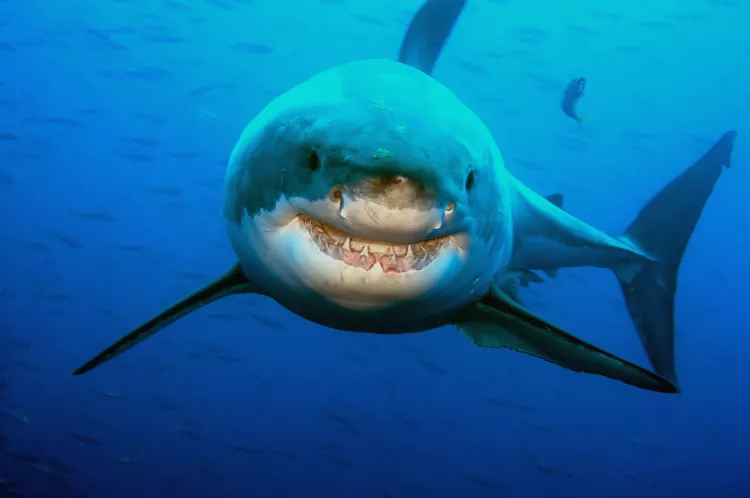
X-RAY MAG: Can you give us a description of what happens to one of your clients when they came back up from such an experience?
AN: They could not wait to go back into the water. It was just amazing (for them). First of all, I would have looked out to see if they were shaking or not shaking. Yes, some of them said they wanted to wait until the next turn (to swim with the sharks), and of course, they did… nobody pushed them. So, those more forthcoming got in first. Then, the others see the first person go in and get out and say that they could not wait to go in the second time, they couldn’t wait to swim again with the sharks, and that’s how every day continued.
What’s happening is... it is like melting ice, because you are melting all this resistance, all those preconceived notions, and all those messages you had in your mind before. And every time the ice melts, or the resistance melts, or the negative sentiments melt, the more each person could have the sensation of really being with these animals at once in the same water, without all this sensationalism and all this irritation, and experience peace and joy and appreciation of being with them in the water.
X-RAY MAG: Have you had any women do it?
AN: Yep. We have women do it. Young and old. (The youngest was) about 29.
And men... one in his twenties. And we had in the last trip, an elderly man. He was 75.
So, the whole gamut. It makes no difference… American, European, men, women, I have seen each one of them have an enjoyable experience.
X-RAY MAG: Where and how often do you do this encounter?
AN: Guadelupe, off Mexico. I start with once (per year). I need at least ten people to run a trip, and if we have enough, then we run a second trip. But we usually start with one at least.
X-RAY MAG: How do divers contact you and sign up for the encounter?
AN: The simplest way is to go to BigAnimals.com. That’s what I do, that’s my expertise in the past 35 years. I gave myself a mission to search for and locate encounters, safe encounters, with all of the big animals in the ocean including the Great White and the polar bear, including the leopard seals, the Blue whales and the Anaconda.
There is no difference between any of these animals (when talking about behaviour). All these animals have only one mechanism. If we irritate them and aggravate them, yes, they will attack the source of aggravation. If we actually enclose them or box them in, then they will try to break the box, like they tried to do with Steve Irwin, but when we keep the number of people to a minimum, and we are not more than one target in the water—like with Humpback whales, with Blue whales, with Great White sharks—a small number of people together as one unit, the animal does not feel trapped.
They see us as only one target, and they can deal with it. As long as they can deal with it, there is no aggression I have ever felt from any of them. Some animals just run away when the group separates for one reason or another, and it was mostly the case of separation. They just left us behind, which they do very easily. They are much faster than us. And with the Great White, it just turns around, and it’s gone. We turn them off with the camera flash or one reason or another, and never do we have the chance or reason, really, to push them with the stick.
X-RAY MAG: What preparation and orientation do you give to divers that sign up for the Great White encounter?
AN: The diver will go through a very thorough orientation and very thorough preparation before the trip. Not everybody is qualified to do the encounter. I need to know in the interview that I run with each passenger before the trip, or if they express interest, to go out of the cage. They have to sign a quite lengthy document—a legal document—that is signed not just by the person him/herself, but also by a family or business lawyer. It has to be signed by a notary public to make sure that the information and the lawyer are legal and authenticated. So, everybody is aware.
Like any drysuit or a motorcycle, utilizing this equipment can be dangerous for your life. You might die if you do that. And the people sign their life away and learn the ramifications of it all. Even then, they are not yet qualified to go out of the cage, because the second element that is very important for me is total and absolutely perfect buoyancy control in the water. It is something I work on with the diver when they get on the trip and before we get out of the cage. When people perform at this level, only then do they go out of the cage.
During the process, there is something that I have learned profoundly from a classic event that happened several years ago on Mount Everest, which has become a motto in my life, and is in the book, Into the Thin Air, (by Jon Krakauer, the mountaineer’s epic account of the 1996 tragedy on Everest that claimed five lives)—a story in which a recreational climber wants to reach the top of Mount Everest. (People) are going to Everest on a regular basis now. There are actually pilgrims... tens, if not, a hundred teams every year during the season of recreational climbers.
I call this trip with the Great White shark the Mount Everest of diving, because if not climbing physically, we are all climbing emotionally, overcoming our fear, overcoming the sentiment of fear and danger that has been embedded in our minds.
So, what happened at Everest is that despite the warning from the leaders, six or eight of the customers tried to go without the leaders to the top. One of the leaders joined them for whatever reason, and I am not going to judge what happened at Everest, however, the result was very devastating, and people perished including the leader that led them and joined them on the trip. I learned a good lesson from that, and the lesson that I apply is the fact that I tell everybody that is coming on the trip that during the trip, during the out-of-the-cage operation, there is only one god, and it is not the one above, it the one by your side, and that’s me. Only if they give me this right and allow me to make the calls—no if’s, but’s or maybe’s—I will let them in, and I will let them out of the cage, and I will lead them back to the cage. And that is safety for me, and that is leadership.
I guess I have the upbringing of being a leader, being in the military in Israel, being an officer, going through a military activity in the battlefield for numerous years and numerous occasions, working undercover in many environments and foreign environments. There is not much more danger in those fields compared to being with sharks, compared to being in the water.
There is, interestingly enough, another part of my history that is important to share.
Anybody who has dived the Red Sea knows the part that is called the Blue Hole. Many people have perished in the Blue Hole—about a hundred people, if one looks at the records.
For the record, for anybody reading this material, in 1988, I ran single-handedly over 3000 people to the Red Sea and introducing at least 500 of them to diving in the Blue Hole. And we did not lose one person. This was 29 years ago between 1980-88.
I introduced, personally, groups of 10-12 people down to 180 feet or 200 feet and went through the passage and out the opposite side and lost not even one person. No one got bent, and there were no embolisms, simply because we adhered to basic rules and protocol of behaviour and lead by them, despite other things that are known today.
Perhaps, we cannot make (the information) public knowledge. We cannot make it known to the common people, but when customers join the leader and let the leader lead, then one can perform successfully. You can push the envelope without breaking it.
But if you try to do it on your own without experience, just because of ego, or whatever, accidents do happen. But if you have a leader who shows a track record, like mine in the military—which is not important for anybody because it is out of the rim (of context)—but at least in the diving I did in the Red Sea and all kinds of diving I have done all around the world since the mid-70’s from the North Pole all the way to Antarctica, and with all the big animals including the Anaconda, the polar bear, the Blue whale, and the Humboldt Squid, I feel and I know by the fact that while leading people on Big Animals expeditions over the last 20 years, we have not had one accident—either diving or animal, or animal interference—that I could also lead people to swim with the Great White.
X-RAY MAG: Do people change after such an encounter?
AN: Oh yeah, they change internally. Because they go back home, and they tell the story. They become ambassadors of the big animals. That’s the key. If I am the ambassador of taking pictures of the big animals, they become the ambassadors of telling the stories, because these are stories that operators, or other magazines, claim they cannot make public. Then the public will not know.
The public should know through the experience of the individual, because those other editorial magazines are constrained by the big—I am sorry to say—squareness of the publications, or because of liability or whatever else they may have, or because they cannot endorse what I have been doing because I do it personally.
Well, the reality is that’s not the case. People drive fast anyway. They go to the statusphere anyway because they have 30 million dollars they can pay.
People will do a lot of different things because of their imagination and are able to push their own limits and are not constrained, like the companies that have liability issues are and therefore cannot talk about it. People can go to the stars as well, and people can buy Ducates and drive 180 miles per hour, like myself (laughs), or people buy Porches because they can and they will and they can take the risk and manage their own risk and do it safely.
X-RAY MAG: There is quite a passion underlying it all. Is there anything else you would like to add?
AN: Just do it! (laughs)
X-RAY MAG: Yes, I think that sums it up nicely. ■
Contact Amos Nachoum
www.biganimals.com
Phone number +1 415 923 9865
email address GreatWhiteShark@biganimals.com

